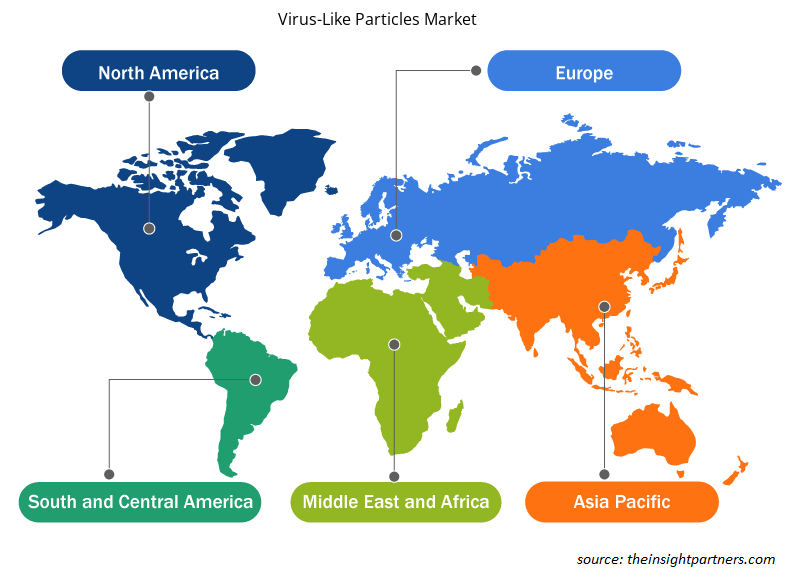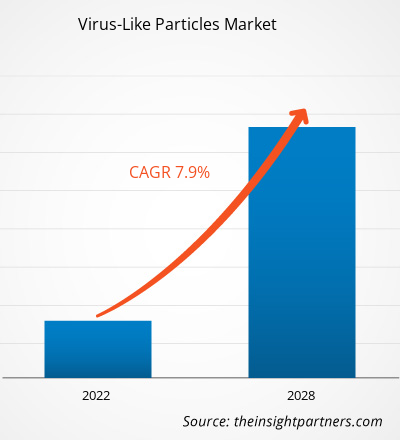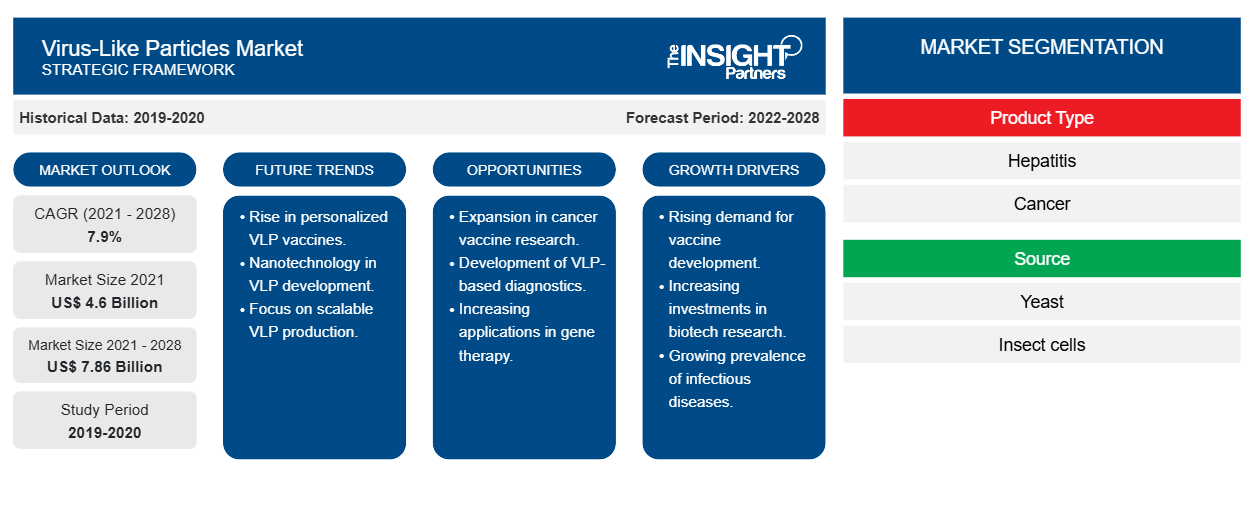바이러스 유사 입자(VLP) 시장은 2021년 46억 184만 달러에서 2028년 78억 5,882만 달러로 성장할 것으로 전망되며, 2021년에서 2028년까지 연평균 성장률 7.9%로 성장할 것으로 예상됩니다.
인간과 동물 바이러스에 대한 바이러스 유사 입자 기반 백신의 상용화, 바이러스 유사 입자 기반 바이러스 백신 개발을 위한 활발한 연구 개발 활동, 알레르기 질환에 대한 신뢰할 수 있는 면역 요법 플랫폼으로 부상하는 바이러스 유사 입자는 전반적인 시장 성장을 담당하는 주요 원동력입니다. 그러나 eVLP의 설계, 정제 및 보관과 관련된 기술적 과제는 전반적인 시장 성장을 방해합니다. 또한 바이러스 유사 입자 백신 제조와 관련된 복잡성과 프로세스의 과도한 비용 및 시간 요구 사항(예: 바이러스 유사 입자 기반 백신의 하류 처리)은 글로벌 시장 성장을 더욱 제한합니다. 나아가 국소 및 신종 바이러스 질환과 암을 위한 바이러스 유사 입자 기반 치료제는 아직 개발 중이며, 이는 전반적인 시장 성장에 수익성 있는 기회를 제공합니다.
북미는 2021~2028년 동안 바이러스 유사 입자 시장 에서 우위를 계속 유지할 가능성이 높습니다 . 미국은 북미 시장에서 가장 큰 점유율을 차지하고 있으며 예측 기간 동안 이러한 추세가 지속될 것으로 예상됩니다. 이는 주로 다양한 변종으로 인한 바이러스성 독감과 같은 바이러스 감염에 대한 사람들의 공통적으로 관찰되는 감수성 때문입니다. 게다가, 생약독화 백신 제조에 필요한 지속적인 R&D 활동으로 인해 생물제약 회사는 바이러스 유사 입자를 선택해야 하며, 이는 시장 성장을 더욱 뒷받침합니다.
귀하의 요구 사항에 맞게 이 보고서를 사용자 정의하세요
이 보고서의 일부 또는 국가 수준 분석, Excel 데이터 팩을 포함하여 모든 보고서에 대한 사용자 정의를 무료로 받을 수 있으며 신생 기업 및 대학을 위한 훌륭한 혜택과 할인 혜택을 이용할 수 있습니다.
-
이 보고서의 주요 시장 동향을 알아보세요.이 무료 샘플에는 시장 동향부터 추정 및 예측까지 다양한 데이터 분석이 포함됩니다.
시장 통찰력
상용화된 바이러스 유사 입자 기반 백신이 전체 시장 성장을 견인합니다.
Frontiers Media SA에서 발행한 보고서에 따르면, 최초의 바이러스 유사 입자 기반 백신은 치명적인 바이러스인 B형 간염 을 퇴치하기 위해 설계되었으며 , 바이러스 유사 입자 기반 백신은 기존 백신에 비해 유망한 안전성 결과를 보였습니다. 최초로 상용화된 바이러스 유사 입자 기반 백신은 HBV에 대한 것이었습니다. 또한, GlaxoSmithKline에서 제조한 "Engerix"와 Merck & Co.에서 제조한 "Recombivax HB"라는 상용 항-HBV 백신은 1980년에 승인되었으며, 모두 바이러스 유사 입자였습니다. 그 다음으로 상용화된 바이러스 유사 입자 기반 백신은 "Gardasil"로, 2006년에 인간 유두종 바이러스(HPV) 감염을 예방하기 위해 승인되었습니다. 또한, 바이러스 유사 입자는 수의학에도 사용됩니다. 바이러스 유사 입자를 기반으로 한 최초의 상용화된 수의학 백신은 돼지 서코바이러스 2형(PCV2)에 효과적인 것으로 입증되었습니다.
알레르기 질환에 대한 면역 요법 제품 개발에서 바이러스 유사 입자의 역할은 전반적인 시장 성장을 더욱 자극합니다. 바이러스 유사 입자는 알레르기성 비염, 천식 및 진드기 반응의 치료에 사용됩니다. 앞서 언급한 요인은 전체 바이러스 유사 입자 시장의 기하급수적 성장을 촉진합니다. 바이러스 유사 입자 백신은 가벼운 피부 반응을 부작용으로 하며 빠른 면역 반응을 보였습니다.
제품 유형 기반 통찰력
제품 유형에 따라 바이러스 유사 입자 시장은 간염, 암/HPV, 고셰병으로 세분화됩니다. 간염 부문은 2021~2028년 동안 큰 시장 점유율을 차지할 것입니다. Frontiers SA 보고서는 C형 간염 바이러스(HCV)가 전 세계 인구의 2%를 감염시키고 간 질환과 간 이식의 주요 원인이라고 지적합니다. 이러한 의학적 위협은 새로운 항바이러스 요법을 도입함으로써 부분적으로 해결할 수 있습니다 . 예를 들어, 고위험 정맥 주사 약물 사용자를 대상으로 하는 50~80% 효능의 백신은 인구에서 HCV 발생률을 극적으로 줄입니다. 따라서 바이러스 유사 입자는 적응 면역 반응을 유도하는 안전하고 면역원성이 높은 백신 전달 플랫폼을 나타냅니다. 현재 여러 바이러스 유사 입자 기반 백신이 임상 시험에 있지만 HBV 및 HPV에 대한 허가된 VLP 백신은 오랫동안 사용되어 왔습니다. 따라서 바이러스 유사 입자 기반 백신은 유리한 면역학적 특성과 관련하여 효과가 입증되었으며, 이를 통해 유망한 HCV 백신 중 하나가 되었습니다.
소스 기반 통찰력
출처에 따라 바이러스 유사 입자(VLP) 시장은 효모, 곤충 세포, 식물 및 기타로 세분화됩니다. 효모 세그먼트는 상당한 시장 점유율을 보유하고 있으며 예측 기간 동안 유사한 추세를 지속할 것으로 예상됩니다. 바이러스 유사 입자는 효모 또는 바큘로바이러스, 식물 및 박테리아를 포함하는 이종 발현 시스템에 의해 생성됩니다. 효모 발현 시스템을 사용하여 생산된 바이러스 유사 입자 기반 백신의 안전성은 효모 기반 바이러스 유사 입자 시장 성장에 기여합니다.
애플리케이션 기반 통찰력
응용 프로그램별로 바이러스 유사 입자 시장은 백신과 치료제로 세분화됩니다. 백신 부문은 2021년에 상당한 시장 점유율을 차지할 것이며, 예측 기간 동안에도 시장에서 우위를 유지할 가능성이 높습니다. 예방 접종은 인간과 동물 모두에서 병원균을 제어하고 질병을 예방하는 가장 효과적인 방법 중 하나로 간주됩니다. 바이러스 유사 입자 기반 백신은 고유한 면역원성과 안전성으로 인해 가장 매력적인 접근 방식 중 하나입니다. 예를 들어, 바이러스 유사 입자는 안전하고 효율적인 체액 및 세포 면역 반응을 유도하는 데 적합한 입자 구조를 가진 비감염성 다중 항원입니다. 그 외에도 바이러스 유사 입자 백신은 수의학 분야에서 효과가 입증되었습니다. 바이러스 유사 입자는 토착 바이러스의 게놈이 없고 세포에서 자가 복제가 불가능한 하나 이상의 구조 단백질로만 구성됩니다. 그러나 단가 또는 다가 항원을 포함하는 바이러스 유사 입자는 혈청학적 감시 요건을 준수하여 생산될 수 있으며, 바이러스 유사 입자 백신의 유용성은 수의학 분야에서 유망한 것으로 입증되었습니다. 동물 질병에 대한 감염 동물과 백신 접종 동물을 구별하는(DIVA) 백신 전략에서 바이러스 유사 입자 백신을 활용하는 한 가지 예입니다.
바이러스 유사 입자(VLP) 시장에서 활동하는 회사들은 전 세계적으로 변화하는 고객 수요를 충족하기 위해 제품 혁신 전략을 채택하고 있으며, 이를 통해 글로벌 시장에서 브랜드 이름을 유지할 수 있습니다.
바이러스 유사 입자 시장 보고서 범위
바이러스 유사 입자 시장 지역 통찰력
Insight Partners의 분석가들은 예측 기간 동안 바이러스 유사 입자 시장에 영향을 미치는 지역적 추세와 요인을 철저히 설명했습니다. 이 섹션에서는 북미, 유럽, 아시아 태평양, 중동 및 아프리카, 남미 및 중미의 바이러스 유사 입자 시장 세그먼트와 지리에 대해서도 설명합니다.

- 바이러스 유사 입자 시장에 대한 지역별 특정 데이터 얻기
바이러스 유사 입자 시장 보고서 범위
| 보고서 속성 | 세부 |
|---|---|
| 2021년 시장 규모 | 46억 달러 |
| 2028년까지 시장 규모 | 78억 6천만 달러 |
| 글로벌 CAGR (2021-2028) | 7.9% |
| 역사적 데이터 | 2019-2020 |
| 예측 기간 | 2022-2028 |
| 다루는 세그먼트 |
제품 유형별
|
| 포함된 지역 및 국가 |
북아메리카
|
| 시장 선도 기업 및 주요 회사 프로필 |
|
시장 참여자 밀도: 비즈니스 역학에 미치는 영향 이해
바이러스 유사 입자 시장 시장은 소비자 선호도의 변화, 기술 발전, 제품의 이점에 대한 인식 증가와 같은 요인으로 인해 최종 사용자 수요가 증가함에 따라 빠르게 성장하고 있습니다. 수요가 증가함에 따라 기업은 제품을 확장하고, 소비자의 요구를 충족하기 위해 혁신하고, 새로운 트렌드를 활용하여 시장 성장을 더욱 촉진하고 있습니다.
시장 참여자 밀도는 특정 시장이나 산업 내에서 운영되는 회사나 기업의 분포를 말합니다. 주어진 시장 공간에 얼마나 많은 경쟁자(시장 참여자)가 존재하는지 그 규모나 전체 시장 가치에 비해 나타냅니다.
바이러스 유사 입자 시장에서 운영되는 주요 회사는 다음과 같습니다.
- 머크앤코(주)
- 글락소스미스클라인 주식회사
- 화이자 주식회사
- 다이나백스 테크놀로지스
- 사노피
면책 조항 : 위에 나열된 회사는 어떤 특별한 순서에 따라 순위가 매겨지지 않았습니다.

- 바이러스 유사 입자 시장 주요 주요 업체 개요 알아보기
바이러스 유사 입자(VLP) 시장 – 제품 유형별
- 간염
- 암/HPV
- 고셰병
바이러스 유사 입자(VLP) 시장 – 출처별
- 누룩
- 곤충세포
- 식물
- 기타
바이러스 유사 입자(VLP) 시장 – 응용 분야별
- 백신
- 치료학
바이러스 유사 입자(VLP) 시장 – 지역별
-
북아메리카
- 우리를
- 캐나다
- 멕시코
-
유럽
- 프랑스
- 독일
- 이탈리아
- 영국
- 스페인
- 유럽의 나머지 지역
-
아시아 태평양(APAC)
- 중국
- 인도
- 대한민국
- 일본
- 호주
- APAC의 나머지 지역
-
중동 및 아프리카(MEA)
- 남아프리카 공화국
- 사우디 아라비아
- 아랍에미리트
- MEA의 나머지
-
남미 및 중미(SCAM)
- 브라질
- 아르헨티나
- 나머지 SCAM
회사 프로필
- 머크앤코(주)
- 글락소스미스클라인 주식회사
- 화이자 주식회사
- 다이나백스 테크놀로지스
- 사노피
- 완타이 바이오팜
- 세럼 인스티튜트 오브 인디아 Pvt. Ltd.
- 바라트 바이오텍
- 엘지화학
- VBI 백신 주식회사
- 과거 분석(2년), 기준 연도, CAGR을 포함한 예측(7년)
- PEST 및 SWOT 분석
- 시장 규모 가치/거래량 - 글로벌, 지역, 국가
- 산업 및 경쟁 환경
- Excel 데이터세트
최근 보고서
관련 보고서
사용 후기
구매 이유
- 정보에 기반한 의사 결정
- 시장 역학 이해
- 경쟁 분석
- 고객 인사이트
- 시장 예측
- 위험 완화
- 전략 기획
- 투자 타당성 분석
- 신흥 시장 파악
- 마케팅 전략 강화
- 운영 효율성 향상
- 규제 동향에 발맞춰 대응























 무료 샘플 받기 - 바이러스 유사 입자 시장
무료 샘플 받기 - 바이러스 유사 입자 시장